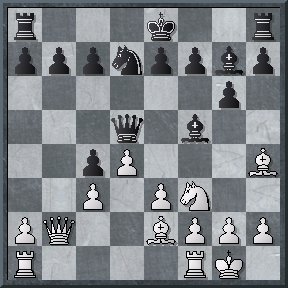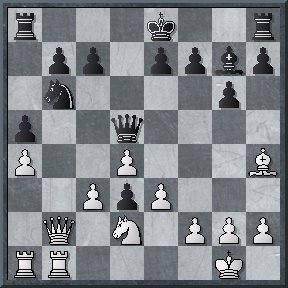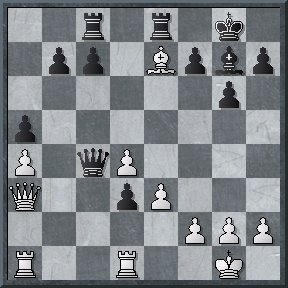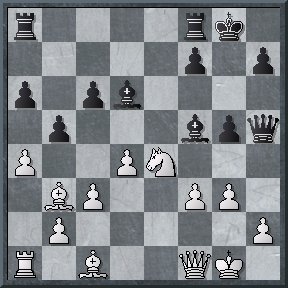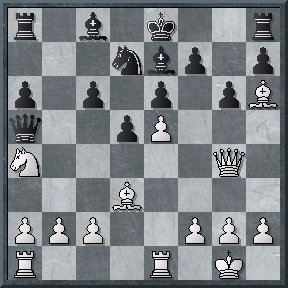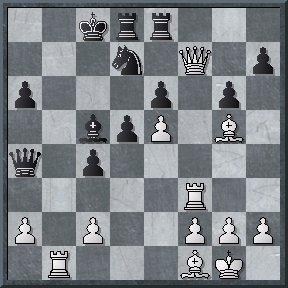09.11.2006
TAL MEMORIAL. GAMES OF ROUND 3 COMMENTED
Round 3 discovered to the world 4 relatively successful opening ideas. Unfortunately, Morozevich`s adhering to dubious variation keeps him off this list. It may also be added that both games where the point was not shared were decided by terrible mistakes, I`d even like to present it as if the round has started with Aronian`s blunder and ended up with Morozevich`s one, but unfortunately I am not sure Aronian-Svidler is the first game to have finished.
Aronian,L (2741) - Svidler,P (2750) D80
Tal Memorial Moscow RUS (3), 08.11.2006
1.d4 ¤f6 2.c4 g6 3.¤c3 d5 4.Ґg5 ¤e4 5.Ґh4 ¤xc3 6.bxc3 dxc4 7.e3 Ґe6 8.Јb1 Јd5 9.¤f3 ¤d7 10.Ґe2 Ґf5 11.Јb2 Ґg7 12.0-0
12...¤b6 Last time against the same opponent Svidler tried 12...e5 13.Јb4 c5 14.Јxc4, Aronian-Svidler, Dortmund 2006, and results of the opening were unsatisfactory. The new move seems to improve the variation, but is clearly unlikely to drive anyone off this variation.
13.a4 a5 14.¤d2 It`sinterestingto note Peter`s combining small subtleties with common ideas of the line. In his game against Jobava in Dortmund the position differed with white queen`s position on d1 instead of b2 and black bishop still on c8, although in that game 7....Јd5 was played instead of 7...Ґe6. As a result of a cute tempo loss black manages to put his bishop to d3.
14...Ґd3 15.Ґxd3 cxd3 16.¦fb1
I am inclined to see at white`s center as a long-term factor promising him a stable advantage, while d3-pawn should be classified somewhere between the notorious "desperator" and the last evaporating remainder of the morning/opening fog. Instead of white`s last move primitive 16.c4 ¤xc4 17.¤xc4 Јxc4 18.Јxb7 0-0 19.Ґxe7 was possible, with some edge, but that would clearly promote d3-pawn up in the pawns rating-list.; after 16.Јb1 black may dare grab the pawn: 16...Јc6 17.Јxd3 ¤xa4
16...Јc6!? Svidler claims the creative idea of this move is to meet 17.Јb5 with 17...e5 so that the queens exchange on c6 should rid black of b7-weakness. I believe simple 18.Јxd3 promises white a stable plus.
17.Јa3 0-0 18.c4?! Everybody agreed here that white should have forced draw here by18.Ґxe7 ¦fe8 19.Ґc5 ¤d7 20.Ґe7 To your underdeveloped chesswise commentator these obvious conclusions are not obvious: why wouldn`t white try to hold the tension by 20.¦b5 b6 21.Ґe7 and also is19.Ґh4!? really that risky? Ґlack may sacrifice a piece 19...¤d5 20.¦b3 ¦xe3 (20...¤xe3 21.fxe3 ¦xe3 is also interesting) 21.fxe3 ¤xe3 22.¤f3 ¤c2 (22...d2 23.¦bb1) 23.Јb2 ¤xa1 24.Јxa1 ¦e8 but would the former desperator compensate the deficiency?
18...¤xc4 19.¤xc4 Јxc4 20.Ґxe7 ¦fe8 21.¦d1 21.¦c1 Јe6 22.¦xc7 ¦ac8! and white is in trouble. 21...¦ac8
22.Ґg5? Ґy 22.¦ac1 Јe6 23.Ґg5 Јg4 24.Ґf4 Ґxd4 25.h3 (25.Јxd3) 25...Јf5 26.¦xc7= white could hold the equilibrium. Now he is to be a pawn down... Or ... 22...c5 23.Јxd3 cxd4
I just had to put this diagram.
24.exd4?? ¦e1+ 0-1 Sorry, Levon and... thank you. Imagine how many mere mortal GMs after commiting such a blunder would now think "It happens" instead of feeling like suicide.
Grischuk,A (2710) - Gelfand,B (2733) C42
Tal Memorial Moscow RUS (3), 08.11.2006
1.e4 e5 2.¤f3 ¤f6 3.¤xe5 d6 4.¤f3 ¤xe4 5.d4 d5 6.Ґd3 ¤c6 7.0-0 Ґe7 8.c4 ¤b4 9.Ґe2 0-0 10.¤c3 Ґf5 11.a3 ¤xc3 12.bxc3 ¤c6 13.¦e1 ¦e8 14.cxd5 Јxd5 15.Ґf4 ¦ac8 16.Ґd3 Јd7 17.¦b1 Ґxd3 18.Јxd3 b6
19.¦e3!? Grischuk demonstrates already for the second time in a row that he didn`t waste his time before the tournament. Instead of traditional 19.d5 he comes out with a new idea of a pawn sacrifice.
19...Ґxa3 20.¤g5 g6 21.¤e4 Ґe7 22.¦be1 White has a promising compensation. Immediate 22.d5 is met with 22...Јf5; 22.Ґh6 deserved attention 22...¦ed8 23.Јe2 ўg7 24.Јd2 h5 25.¦f3 25.¦g3!? 25...f5 26.¤g5 the game could continue 26...Ґxg5 27.Ґxg5 ¦e8 28.¦fe3 ¦xe3 and now either 29.Ґxe3 or29.Јxe3 with compensation. Future analysis will show where white missed the chances. 1/2-1/2
Shirov,A (2720) - Leko,P (2741) C89
Tal Memorial Moscow RUS (3), 08.11.2006
1.e4 e5 2.¤f3 ¤c6 3.Ґb5 a6 4.Ґa4 ¤f6 5.0-0 Ґe7 6.¦e1 b5 7.Ґb3 0-0 8.c3 d5 9.exd5 ¤xd5 10.¤xe5 ¤xe5 11.¦xe5 c6 12.d4 Ґd6 13.¦e1 Јh4 14.g3 Јh3 15.¦e4 g5 16.Јf1 Јh5 17.¤d2 Ґf5 18.f3 ¤f6 19.a4 ¤xe4 20.¤xe4
I woud have definitely been... highly unexpected if this variation had taken Leko by surprise.20...Јg6! An important novelty that solves black`s opening problems After20...Ґxe4 21.fxe4 ўg7 Kurnosov-Azarov, Kusadasi 2006 black position was worse. Leko affirmed after the game his team analysed it all till the end. Please, read once again: "till the end"!
21.¤xd6 Јxd6 22.Ґxg5 ¦fe8 23.¦e1 23.Јf2 Јg6 24.Ґf4 Ґe6 25.Ґc2 Ґf5 23...Јg6 23...c5 24.Ґe7 ¦a7 After24...Ґe6 25.¦xe6! (25.Ґxe6 ¦xe7 26.Ґb3 ¦ae8 27.¦e4 ¦xe4 28.fxe4 bxa4) 25...fxe6 26.Ґd6 white has full compensation for two qualities and initiative.
25.Ґc5 ¦aa8 26.Ґe7 ¦a7 27.Ґc5 1/2-1/2 White king is underprotected on the 2nd rank and draw is a fair result. I should also like to add that this is the 3rd game in a row Leko finishes with draw by moves repetition. Does the Guinness record book have more room for a new article?
Two young talents clash in a fierce combat. Do we have to add that draw was the logical and self-evident outcome?
Carlsen,M (2698) - Mamedyarov,S (2728) [B46]
Tal Memorial Moscow RUS (3), 08.11.2006
1.e4 c5 2.¤f3 e6 3.¤c3 a6 4.d4 cxd4 5.¤xd4 ¤c6 6.¤xc6 bxc6 7.Ґd3 d5 8.0-0 ¤f6 9.¦e1 Ґe7 10.e5 ¤d7 11.Јg4 g6 12.¤a4 Јa5 13.Ґh6
13...c5 I couldn`t find this move in TWIC, but better-equipped colleagues claim the novlety comes just 3 moves later. Ordinary 13...Јb4 leads to a slightly worse endgame for black.
14.b3 c4 15.Ґf1 Ґb7 16.¦e3! That`s it! Direct and strong.
16...Ґc6 17.Јf4 Ґxa4 Black has to be uncompromising, 17...Јc7 18.¤b2 Ґc5 19.¦ee1 is unattractive for him. 18.¦f3
18...0-0-0 18...f6 19.exf6 Ґxf6 20.Јd6 Јc5 21.Јxc5 ¤xc5 22.¦xf6 and white is better. 19.Јxf7 ¦he8 20.bxa4 Ґc5 21.¦b1 Јxa4 22.Ґg5
Perhaps, some improvement hides between the last moves. At least, now black could choose22...Јxc2 23.Ґxd8 ¦xd8 24.Јxe6 Јxb1 25.Јxd5 Јb5 26.Ґxc4 Јb7=/+ and in spite of his open king an extra piece promises black some advantage. After 22...Јc6?! it`s white who has the upper hand.
23.Ґxd8 ¤xe5 24.¦b8+ I think after 24.Јxh7! ¤xf3+ 25.gxf3 ¦xd8 26.Ґh3 the sharp position with opposite-coloured bishop is in white`s favour. Now the complex endgame arises by force.
24...ўxb8 25.Ґc7+ Јxc7 26.Јxe8+ Јc8 27.Јxc8+ ўxc8
28.¦h3 Whitefeels likehe`s had enough imressions. He could have continued playing by 28.¦g3+/= with the idea Ґe2, ўf1, f4 Probably, active position of black pieces and a strong center would have allowed him to hold.
28...¤g4 29.¦f3 ¤e5 30.¦h3 ¤g4 31.¦f3 1/2-1/2
The following game perhaps should be viewed as an illustration of how Fates act. Pono`s fighting spirit together with Moro`s negligence with the opening imbalance the scales. One of the mentioned factors wouldn`t , but the combination of two turns for Morozevich fate to doom, or even to doom 3 if we remember his 3 rounds.
Ponomariov,R (2703) - Morozevich,A (2747) [B81]
Tal Memorial Moscow RUS (3), 08.11.2006
1.e4 c5 2.¤f3 d6 3.d4 cxd4 4.¤xd4 ¤f6 5.¤c3 a6 6.Ґe3 e6 7.g4 d5 Well, yes, there is such move. 8.g5 ¤xe4 9.¤xe4 dxe4 10.Јg4
10...¤d7 Black used to try here10...Јa5+ but failed to equalize in ... both games played by this line 11.0-0-0 Јa5 12.¤b3 Јf5 It was very risky to take the pawn:12...Јxa2 13.Јxe4 Ґe7 14.Ґd3 a5 15.ўd2 (after15.Ґb5 black has 15...0-0! beside obvious15...a4 ) 15...Јxb2 16.Ґd4 Ґb4+ (16...Јa3 17.Ґxg7 Ґxg5+ 18.ўe2 ¦g8 19.Јxh7) 17.ўe2 Ґc3 18.¦b1 white has advantage here. Although white has advantage anyway...
13.Јg3 Ґe7 14.h4 Јf3 It`s more form the psychology. Black almost do not have moves.14...0-0 15.Ґg2 a5 was an alternative. 15.Јh2 Јf5 16.Ґg2 0-0
17.Јc7 Black`s development is severely hindered, yet he hopes to deploy the forces while white is returning the sacrificed pawn. Ponomariov returns the pawn immediately and soon transposes a game to a better ending that seems quite tempting for him. 17.ўb1 could be a useful alternative. 17...Ґd8 18.Јc4 18.Јd6 is subtle and 18.Јg3 is too subtle.
18...Ґb6 19.Ґxe4 Ґxe3+ 20.fxe3 Јe5 21.Јd4 ¦b8 22.h5
22...b6 Could black take the pawn? Yes, the silicone technology allows 22...Јxg5!? 23.h6 e5 24.Ґxh7+ ўxh7 25.hxg7+ ўxg7 26.Јd6 ¤f6 27.Јxb8 Ґg4 28.Јa7 (28.Јxb7 Ґxd1 29.¦xd1 ¤g4) 28...Ґxd1 29.¦xd1 white is still better but the reduction of material gives black good chances to survive. Now h6 pawn is going to be a constant pain for black.
23.h6 g6 24.¤d2 b5 An attempt to improve the knight after 24...Јxd4 25.exd4 e5?! Would result in white`s knight too much activity after 26.Ґc6 exd4 27.Ґxd7 Ґxd7 28.¤e4 or 26.Ґd5 exd4 27.¤e4
25.¤f3 I think white should have looked for a better place for his knight, and that is definitely...f6! 25.Ґc6!? deserved attention with the idea ¤d2-e4-f6 and after 25...Јxd4 26.exd4 Ґb7!? 27.d5 black has serious problems. Ponomariov`s technical approach allows black to hold the position.
25...Јxd4 26.exd4 ¦b6 26...Ґb7 27.Ґxb7 ¦xb7 28.d5 gave white too much activity. 27.¦hf1 b4 28.¦de1 a5
29.¤e5 ¤xe5 30.dxe5 ¦b5 31.Ґd3 ¦c5 32.¦f4 Ґb7 33.¦c4 ¦fc8 34.¦xc5 ¦xc5 35.ўd2 ¦d5 36.¦e4 ўf8 37.c4 ¦c5 38.¦e3 ўe7 39.b3 ўd8 40.Ґe4 Ґc8 41.Ґf3 ўc7 42.ўd3 ўb6 43.ўe4 ¦c7 44.¦d3 ¦d7
Ponomariov`s purely technical approach has led to a position close to drawish bishops ending where white cannot breakthrough. He tries his last chances. 45.¦d6+!? ўc5 46.ўf4! ¦xd6 47.exd6 ўxd6 48.c5+! ўxc5?? Terrible blunder. As it happens often after a successful hard defence Morozevich stumbles just in front of the saving exit.Presumably, being too tired he either missed 51.Ґe4! or simply forgot how the passed pawn in the bishops endgame is held from behind: 48...ўe7! 49.ўe5 Ґa6 50.Ґa8 (50.Ґc6 Ґf1 51.Ґa4 Ґe2 52.c6 Ґf1 53.c7 Ґa6=) 50...Ґe2 51.c6 Ґf1! 52.Ґb7 Ґg2! 53.Ґa8 Ґf1= led to draw.
49.ўe5 Ґa6 50.ўf6 ўd6 51.Ґe4! Ґe2 52.ўxf7 Ґg4 53.Ґxg6 1-0

